Gaufres de Liège (or Belgian Liège Waffles) are the ultimate sweet Belgian treat! These pearl sugar waffles are decadent enough for dessert, yet simple enough for an afternoon snack.
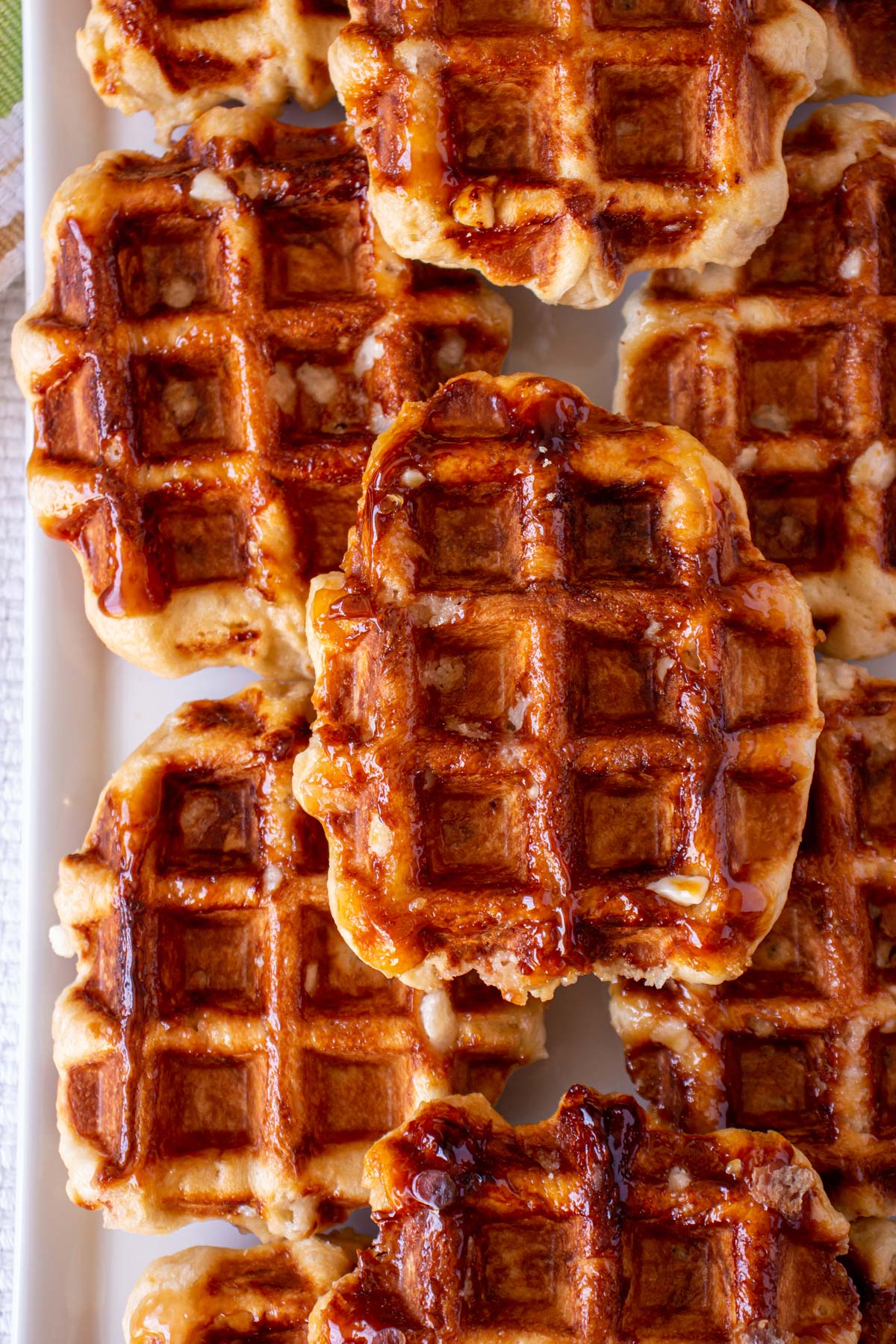
(This recipe was originally published in June 2015, but was updated with new photos and content in 2023).
Just because a waffle is baked in a Belgian-style waffle maker doesn't automatically make it Belgian. If we're going to get technical, a true Belgian Liège waffle (gaufre de Liège aka a Belgian sugar waffle or pearl sugar waffle) is very different from its cousins.
Popularized in Liège, a Belgian city about an hour east of Brussels, authentic Liège waffles are more time consuming to prepare. They feature a rich and buttery brioche dough studded with Belgian pearl sugar. The dough is enriched with butter and egg, and is made with yeast instead of baking powder, giving these pearl sugar waffles a much more complex flavor and texture.
If you've never eaten a real Belgian Liège waffle before, it's very different from what you'd expect. Gaufres de Liège are crunchy, chewy, buttery, and rich, yet delicate, sugary sweet, and so exquisite. It's almost like waffle meets candy, so much more than your basic breakfast.
What happens is the pearl sugar begins to soften and melt in the waffle iron, creating pockets of soft sugar within the waffles, and caramelized sugar coating the pan. When you make more waffles, the caramelized sugar almost becomes like a shellacked sugar coating on the waffle's exterior, resulting in a glistening, golden crunch.
For that reason, these Liège waffles are better enjoyed warm. Once they cool, the sugar cools too resulting in harder waffles. You can easily rewarm them in your oven or toaster oven, if needed.
Ingredient notes

- Belgian Pearl Sugar: Belgian pearl sugar can be a bit challenging to find in stores, but it's easy to find online. Do not confuse it with Swedish pearl sugar, which is vastly different and not an appropriate substitute. Swedish pearl sugar is smaller and used as a topping for baked goods. Meanwhile, Belgian pearl sugar is larger and can tolerate higher heat. You can also try using roughly crushed sugar cubes, although the result won't be same.
- Flour: Use plain all-purpose flour for your Liège waffle dough. As with any baking, it's preferred to weigh your flour (and all your ingredients) using a digital scale rather than measuring in volume (cups) to get the most accurate results.
- Yeast: This recipe uses active dry yeast as the leavening agent for the dough.
- Butter: You'll need a lot of unsalted butter for the dough (that's why it's so rich and delicious!). Leave your butter out at room temperature overnight or for several hours at least until it is soft. If you need to soften it in the microwave, cut it into chunks and do so in short bursts to ensure the butter only barely softens but doesn't start to melt.

How to make it
To the bowl of a stand mixer fitted with the dough hook, add warm milk. Add sugar and yeast and stir to combine (PHOTO 1). Set aside for 5 minutes until the mixture is foamy (PHOTO 2).
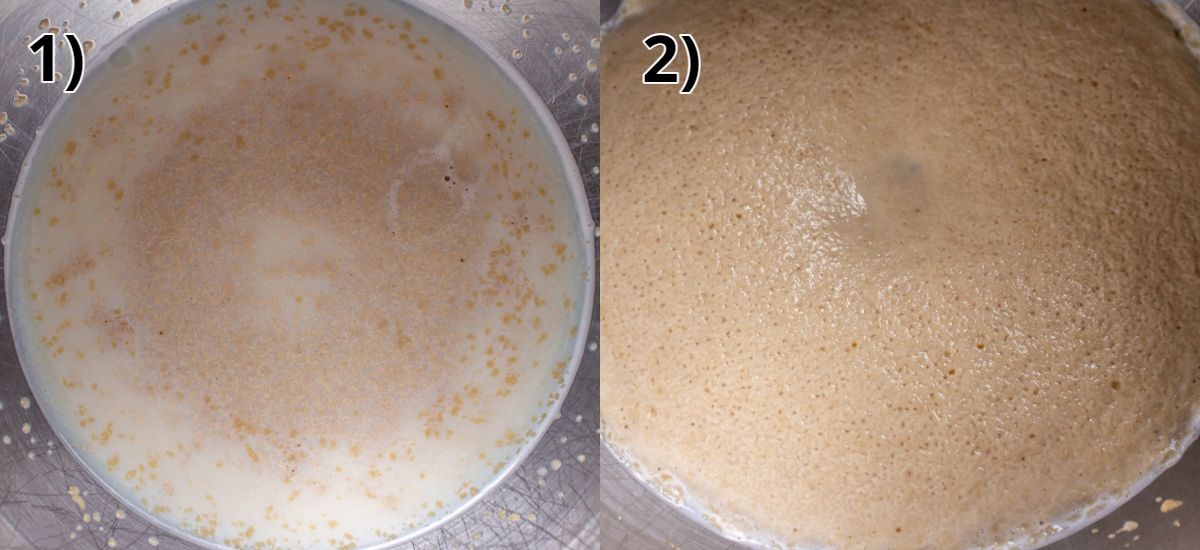
Whisk in eggs and vanilla (PHOTO 3). Then stir in all but about 1 cup flour. Once the flour is mostly combined, stir in the salt (PHOTO 4).
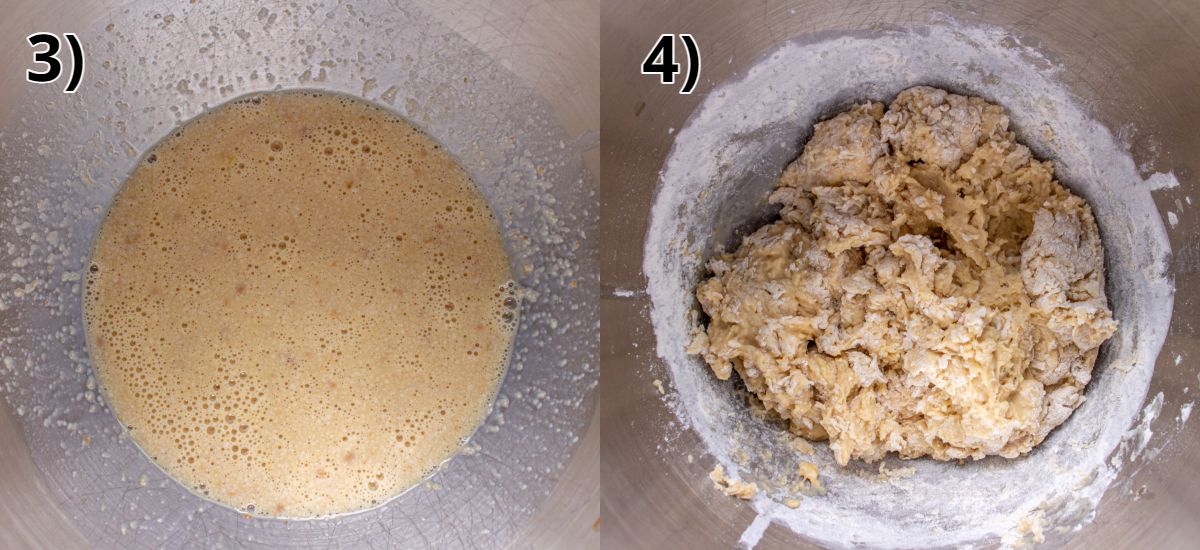
With the stand mixer running on medium-low speed, add soft butter, a little at a time, thoroughly kneading in each addition (PHOTO 5). Scrape down the bowl as needed between additions of butter until all the butter is mixed in smoothly (PHOTO 6).
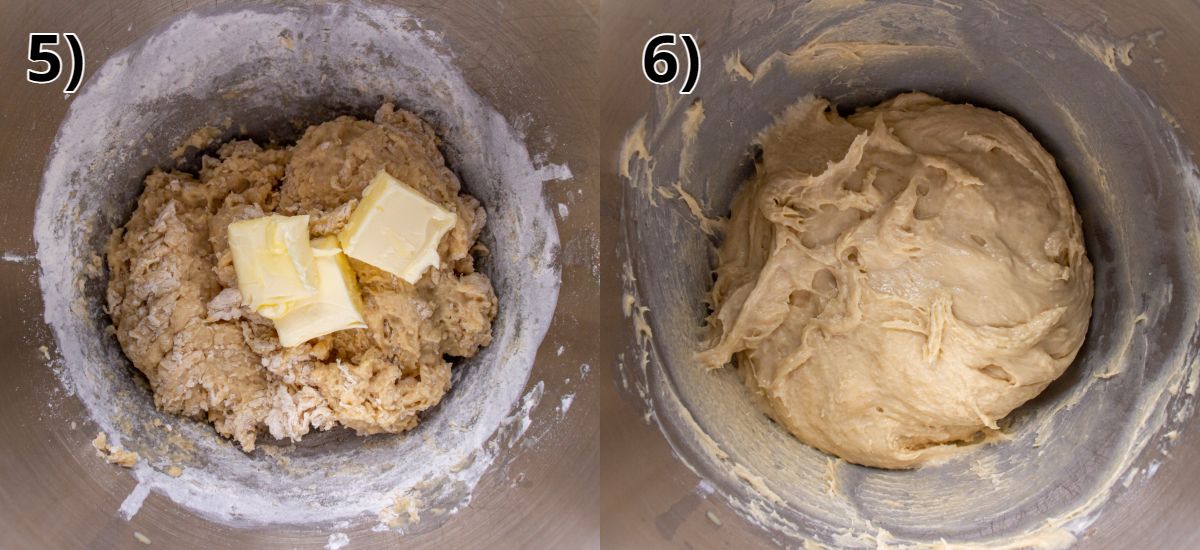
Finally, add the remaining flour and mix with the dough hook on low speed for 5 minutes, or until the dough is stretchy and glossy. It will be quite soft (PHOTO 7). Transfer the dough to a clean, large, lightly greased mixing bowl to proof (PHOTO 8).
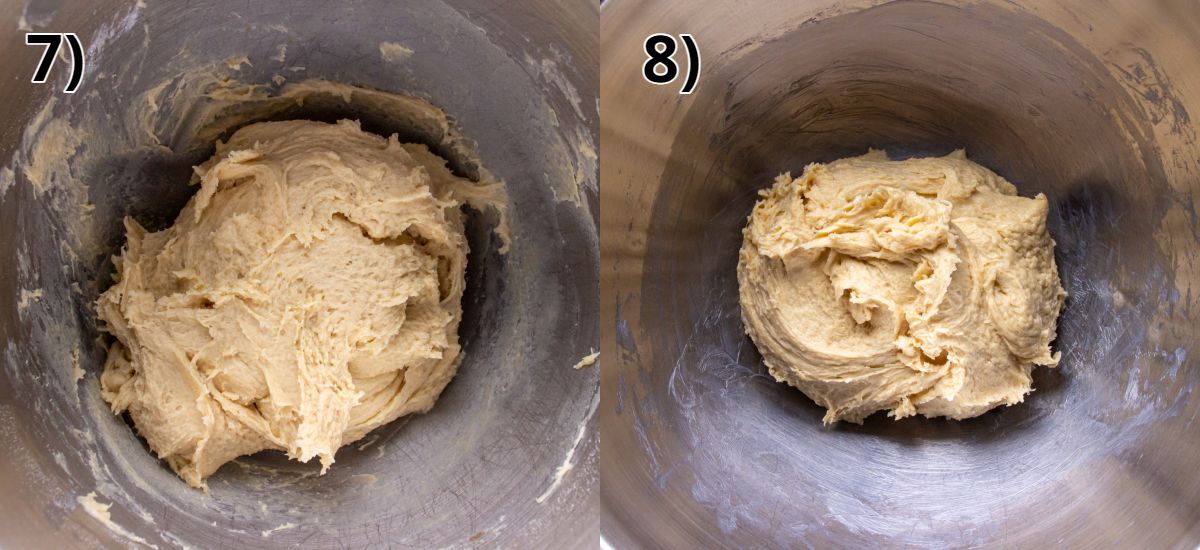
You can let the Belgian Liège waffle dough rise two ways, first at room temperature and then in the fridge, or vice-versa.
For room temperature first: This is my preferred method. Cover the mixing bowl with plastic wrap and leave at room temperature (in a slightly warm, draft-free place) for 1 ½ to 2 hours, or until doubled in size (PHOTO 9). Punch down the dough to deflate (PHOTO 10), re-cover with plastic wrap and let chill in the fridge overnight, or up to 24 hours.
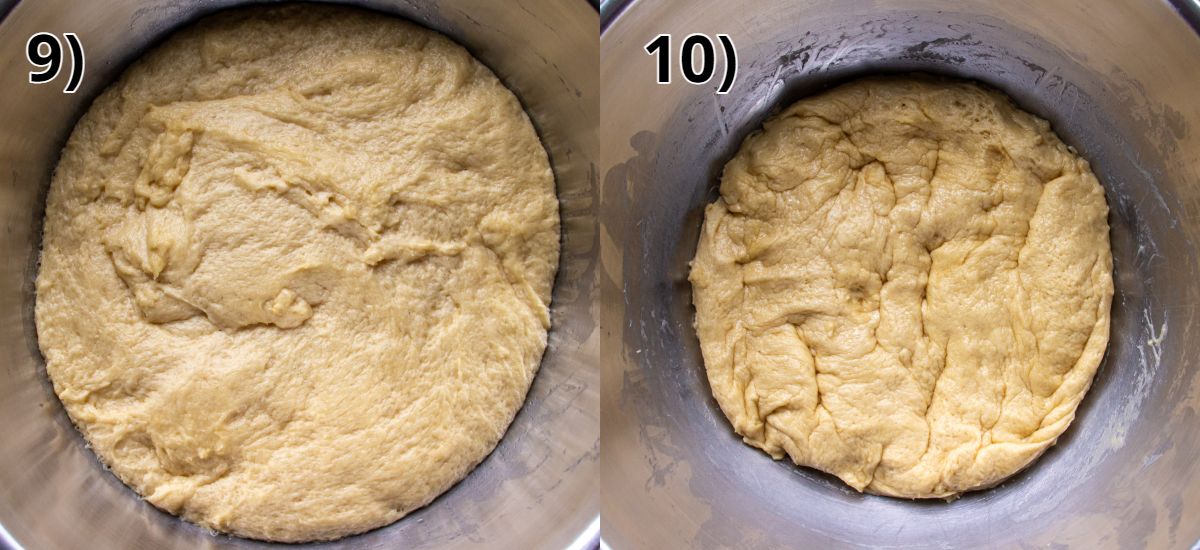
For fridge first: Cover the mixing bowl with plastic wrap and leave it in the fridge overnight, or up to 24 hours. The dough will not look fully doubled when you take it out. The day you want to the make the waffles, bring the dough back to room temperature for 1 hour. Punch down to deflate, and let it rise again for another 1 ½ to 2 hours until doubled in size.
When you're ready to cook the waffles with either proofing method, knead in the pearl sugar. You can do this in a few additions by flattening the dough, topping with some of the sugar, then folding it into the dough (PHOTOS 11-12).
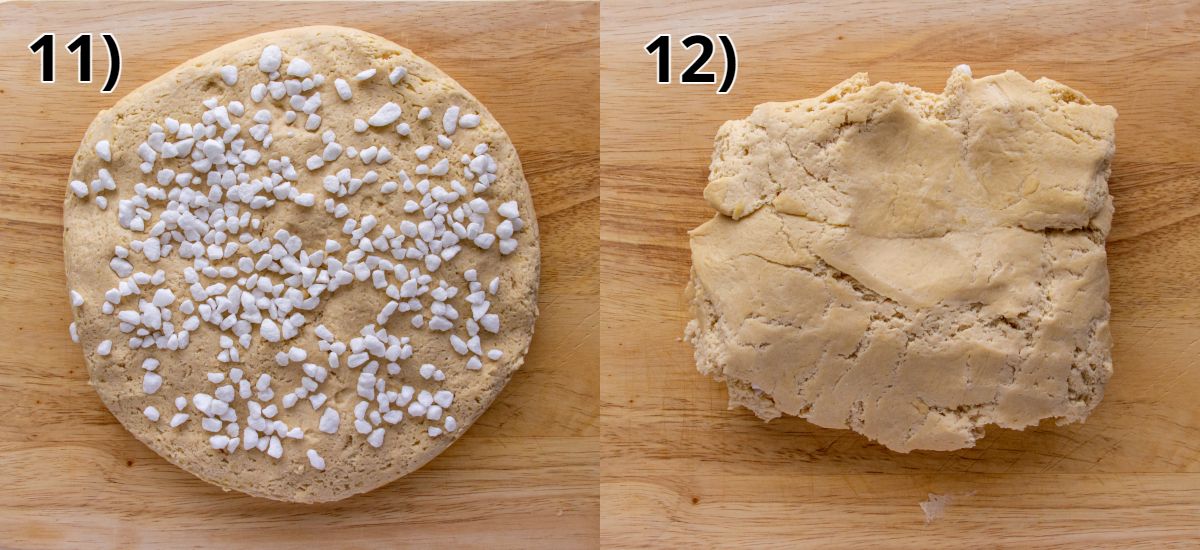
Repeat several more times until you've added all the sugar.
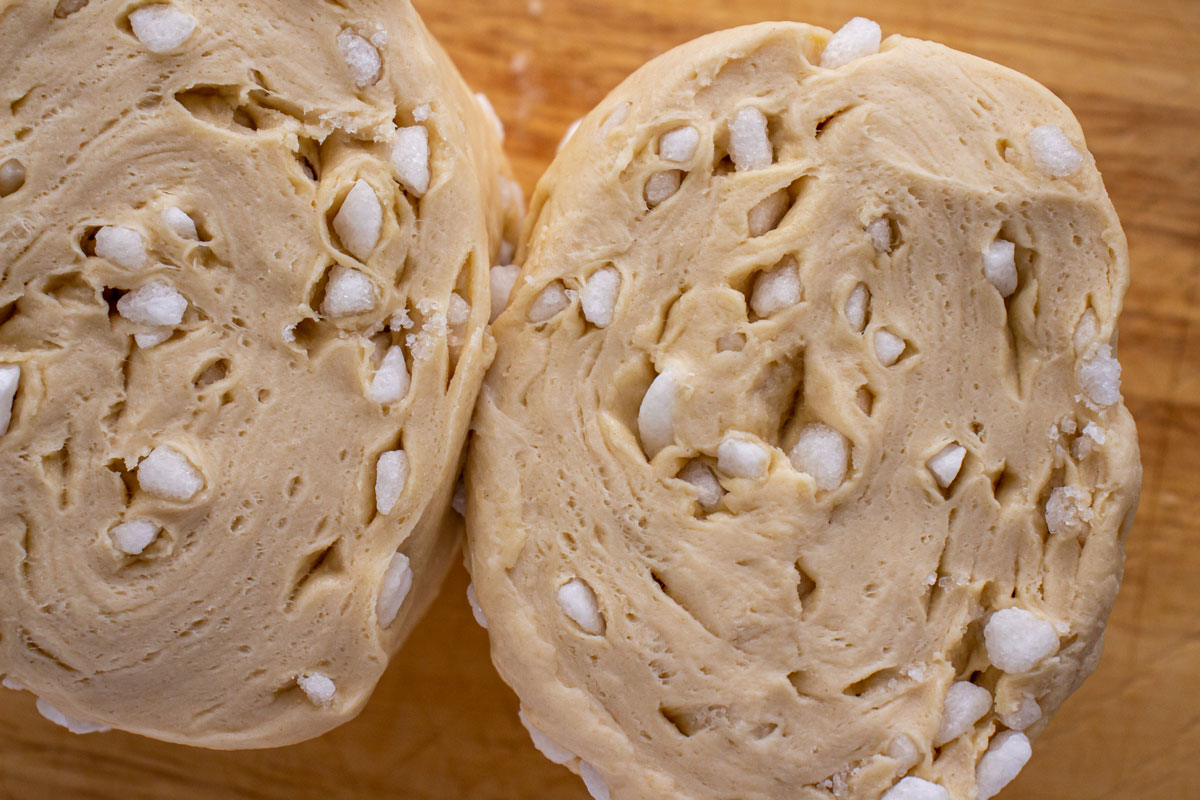
Divide the dough into 16 pieces (roughly 70 grams each). If you don't have a scale, the easiest way to do this is to divide the dough roughly in half, then shape each half into a somewhat flat circle. Cut each circle into 8 wedges like a pizza to yield 16 similar-sized pieces. They won't be exact, but you'll get close.
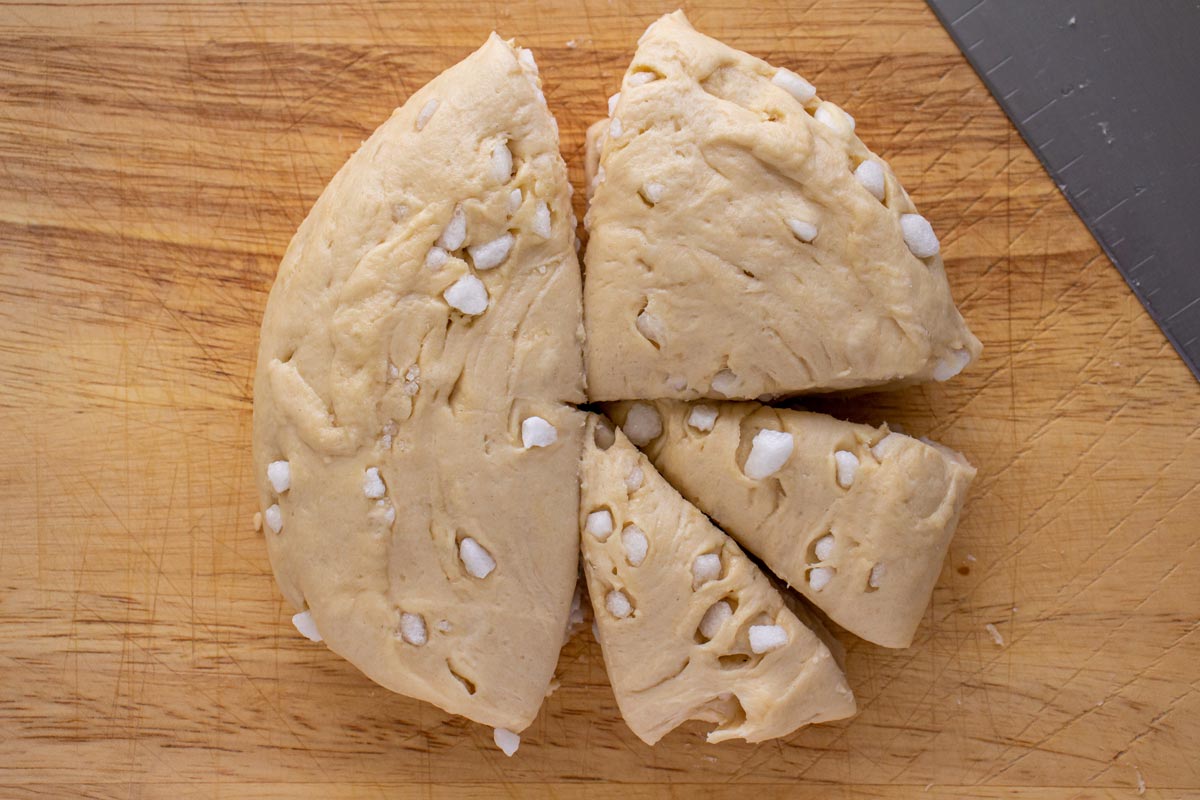
Shape the portioned dough pieces into slightly rectangular or oval discs.
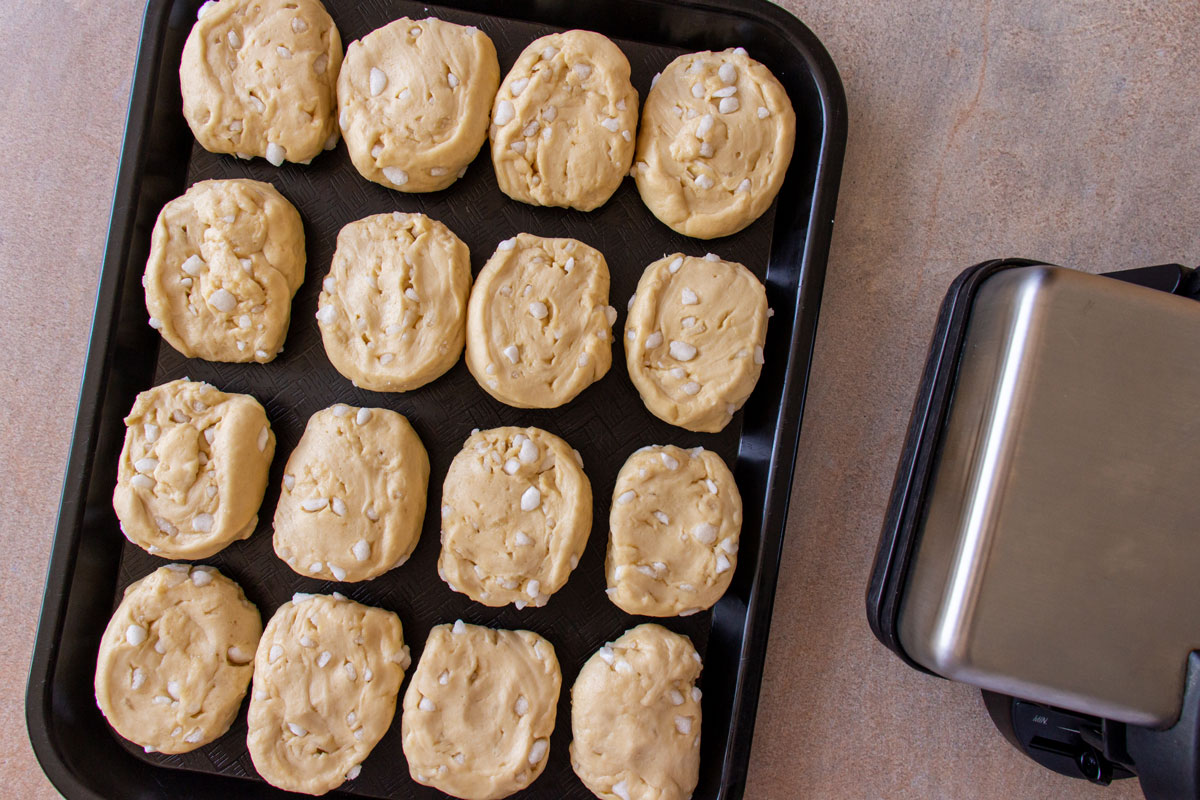
Heat your waffle iron (this is the one I have), preferably a deeper Belgian-style one, over medium heat. Place the first disc of waffle dough on the grid and cook according to the waffle maker’s instructions.
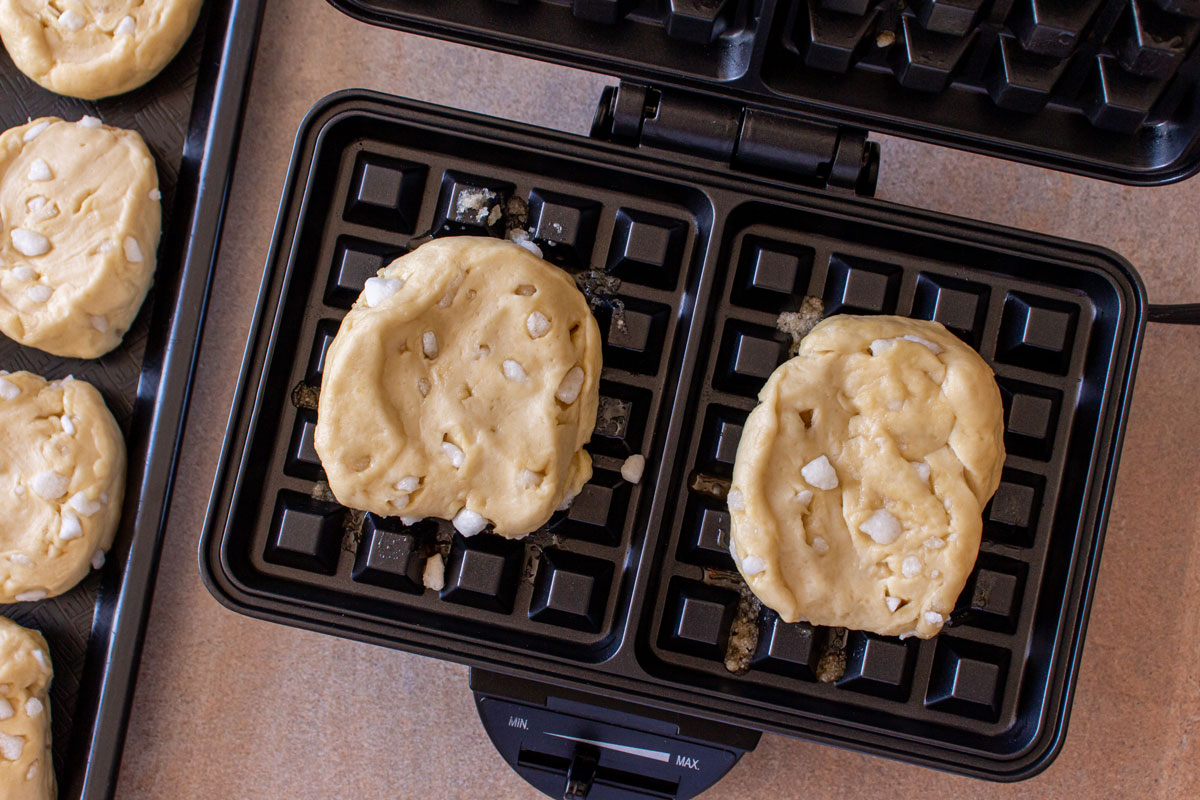
Note: Depending on your waffle iron, you may be able to cook several Belgian Liège waffles at once–mine has a capacity for two rectangular waffles. If you have a round waffle iron, you can also fit two or more of these smaller waffles at a time. Keep in mind that the rectangular waffle iron shape is more authentic for gaufres de Liège.
Cook until deeply golden all over, about 4 to 5 minutes.

Then carefully transfer the pearl sugar waffles with tongs or a fork to a cooling rack. Repeat with the remaining discs of dough, adjusting temperature of waffle iron as needed to get the color you want.
You’ll likely find that the waffles look more caramelized and glossy as you go on. The melted sugar left behind in the grids will caramelize onto the later batches of waffles. You may even end up with a moat of caramelized sugar around the edges of your waffle iron.
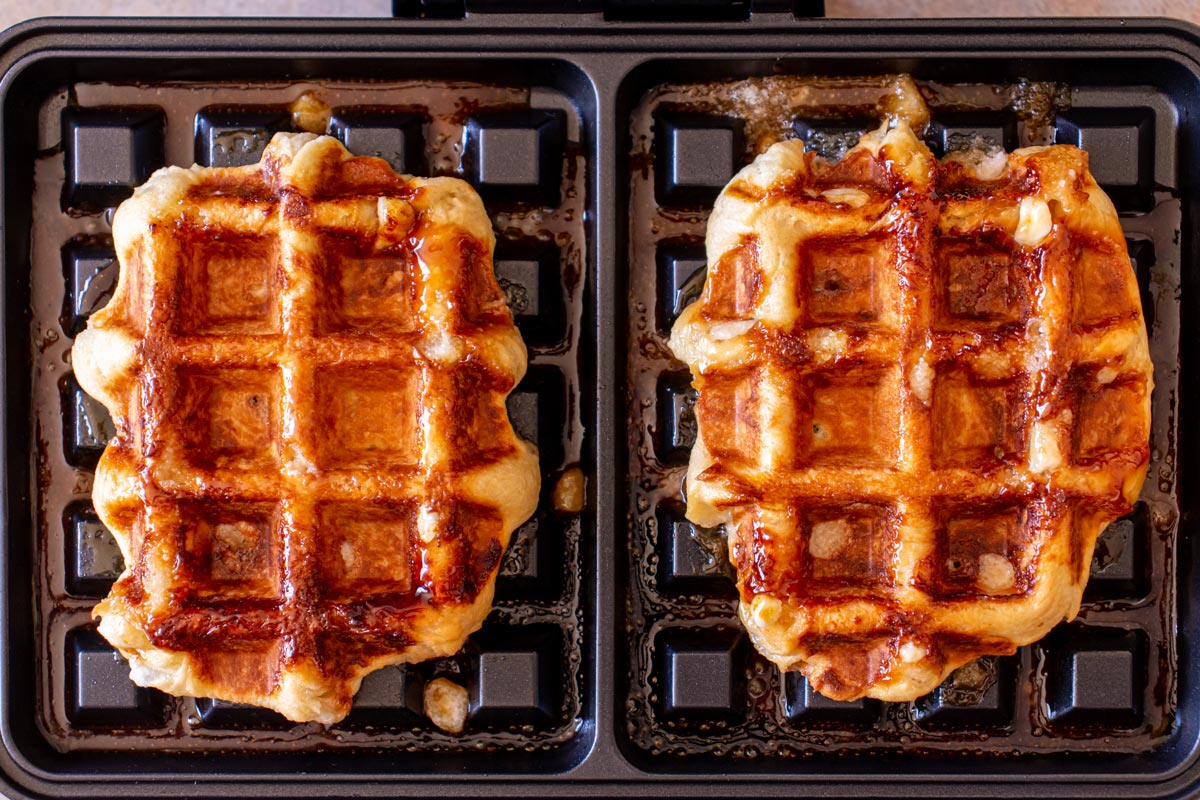
Keep Belgian Liège waffles warm in a 200°F oven if you plan to eat them right away. As the waffles cool, they will harden but will soften again when you rewarm them. For best results, always serve gaufres de Liège warm.
Please scroll to the bottom of the post for the full recipe (in a printable recipe card) including ingredient amounts and detailed instructions.
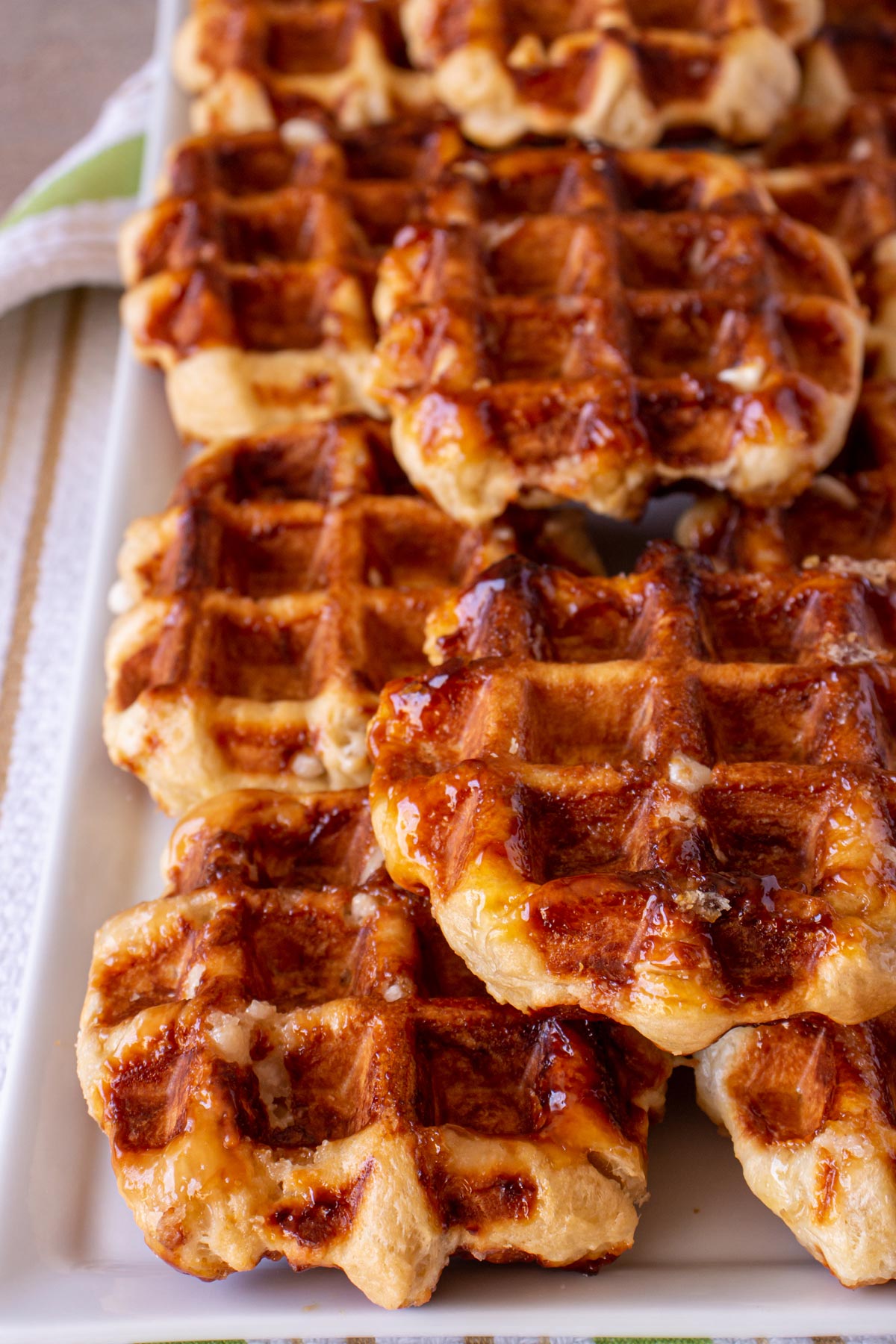
Expert tips
These pearl sugar waffles are quite sweet and rich on their own. They don't really need additional embellishments in the form of syrup, whipped cream, ice cream, fruit, or Nutella, however you can definitely dress them up if you'd like. A little dusting of confectioners' sugar is a popular way to finish them. They're absolutely sublime plain, so don't feel the need to cover them up.
You also don't really need a fork and knife. Belgian Liège waffles are a great snack and can be enjoyed handheld and on the go.
Cleaning your waffle iron after making Liège waffles can be challenging. The sugar caramelizes and can harden quite drastically to the inside of your waffle iron. It's more complicated to clean than wiping down with a wet paper towel. A Belgian waffle iron with removable plates would be ideal in this scenario. If you don't have one of those (I don't either but I might get one in the future), this is how I clean mine:
- I pour a little hot/boiling water onto the bottom plate (very carefully since you can't submerge the machine in water) while the machine is still hot and before the sugar fully cools and hardens on the surface.
- Then I use a small brush to scrub and loosen the sugar.
- Next, I carefully dump out the water (making sure not to get the electrical parts wet). Repeat with more hot/boiling water and scrubbing with a small brush. I also use a toothpick to try and pry and loosen some of the hardened sugar once it softens enough.
- I follow that up with using wet and then dry cotton swabs to finish cleaning between the grids.
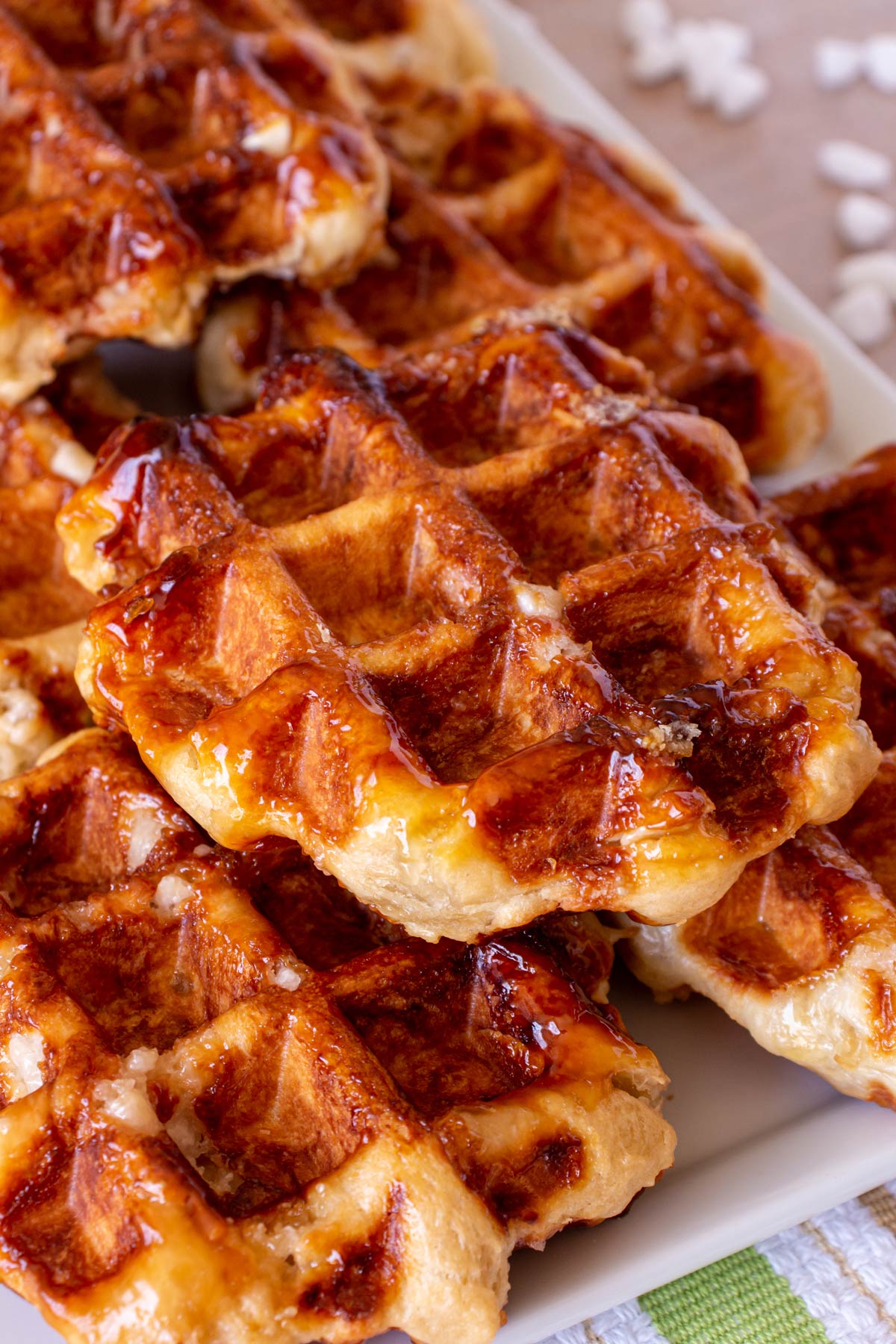
FAQ
Store leftover Belgian Liège waffles in an airtight container at room temperature for a couple days or in the fridge for up to 1 week.
To freeze, arrange the cooked waffles in a single later on a sheet pan and freeze until solid, then transfer to a freezer bag. Freeze for up to 1 month. You can also freeze the dough before baking. Freeze the portioned dough on a sheet pan or tray until solid, then transfer to a freezer bag and freeze for up to 2 months. Thaw the dough overnight in the fridge before cooking as directed.
It's best to reheat your gaufres des Liège before eating! If they were frozen, I prefer thawing in the fridge but you can reheat from a frozen state if needed. Place waffles in a single layer and reheat in the oven or toaster oven at 350°F for about 5 minutes or until heated through.
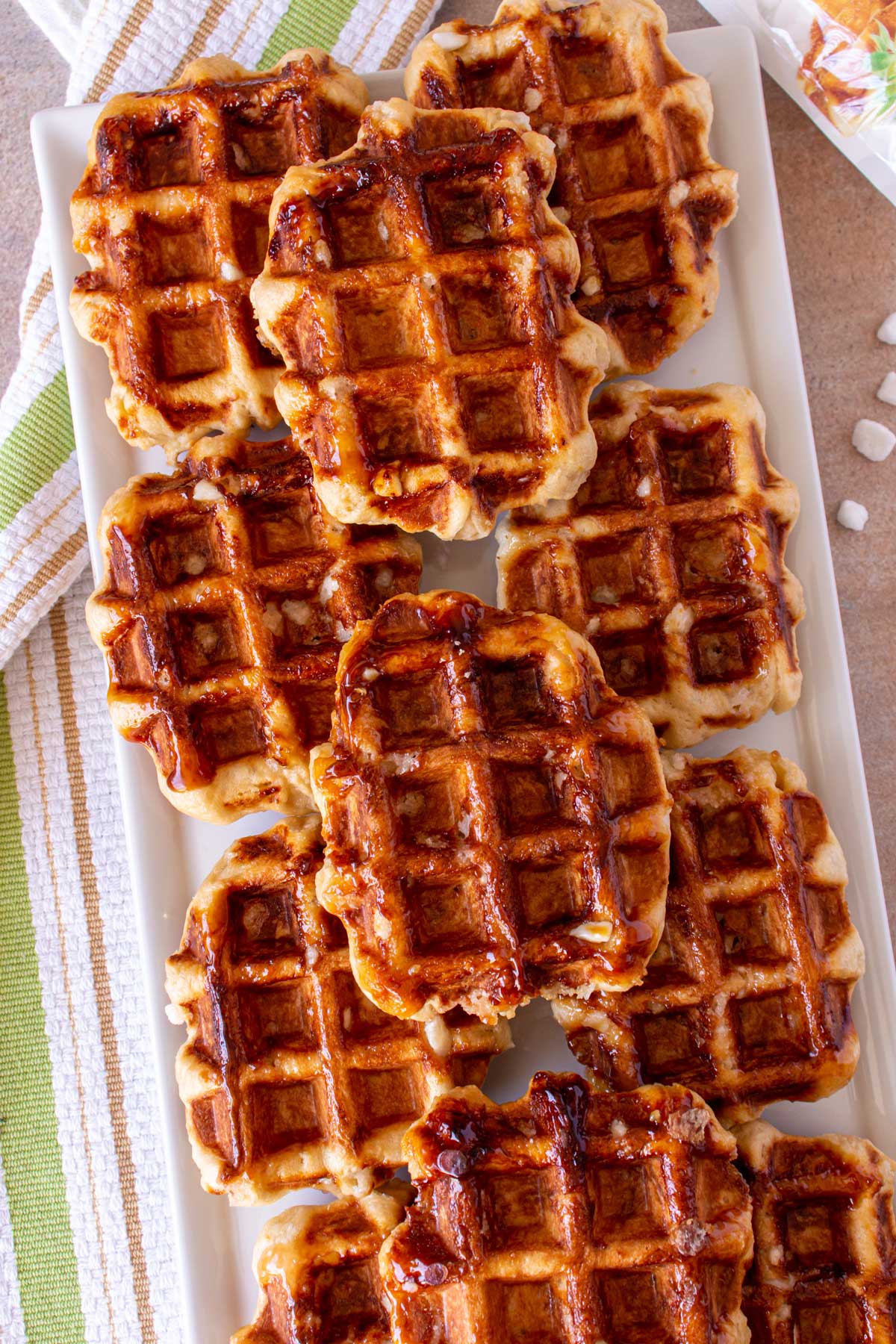
Other recipes you may like
- Lemon Ricotta Waffles with Blueberry Citrus Syrup
- Buttermilk Pumpkin Spice Waffles with Toasted Pumpkin Seeds
- Sour Cream Orange Waffles
- Browse all Breakfast Recipes and Dessert Recipes
Tried this recipe? Please leave a star ⭐️⭐️⭐️⭐️⭐️ rating in the recipe card below and/or a review in the comments section further down the page. You can also follow me on social media on Facebook, Instagram, and Pinterest!
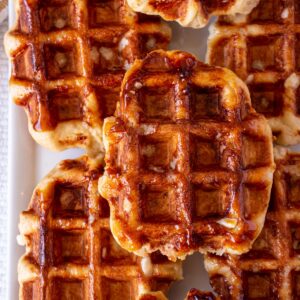
Gaufres de Liège (Belgian Liège Waffles)
Ingredients
- ¾ cup milk warm (between 110°F and 116°F)
- 2 tablespoons raw sugar, brown sugar, or honey
- 1 packet (7 grams or 2 ½ teaspoons) active dry yeast
- 2 large eggs at room temperature
- 2 teaspoons pure vanilla extract
- 460 grams (3 ⅔ cups) all-purpose flour
- 1 teaspoon kosher salt
- 200 grams (14 tablespoons) unsalted butter at room temperature (softened)
- 200 grams (1 ⅓ cups) Belgian pearl sugar
Instructions
- To the bowl of a stand mixer fitted with the dough hook, add the warm milk. Add the sugar and yeast and stir to combine. Set aside for 5 minutes until the mixture is foamy.
- Whisk in the eggs and vanilla, then stir in all but about 1 cup (125 grams) flour using a spoon or the dough hook of the stand mixer. Once the flour is mostly combined, stir in the salt.
- With the stand mixer running on medium-low speed, add the butter, a little at a time, thoroughly kneading in each addition. Scrape down the bowl as needed between additions of butter until all the butter is mixed in smoothly.
- Finally, add the remaining flour and mix with the dough hook on low speed for 5 minutes, or until the dough is stretchy and glossy. It will be quite soft. Transfer the dough to a clean, large, lightly greased mixing bowl to proof. You can let the dough rise two ways, first at room temperature and then in the fridge, or vice-versa.
- For room temperature first, cover the mixing bowl with plastic wrap and leave at room temperature (in a slightly warm, draft-free place) for 1 ½ to 2 hours, or until doubled in size. Punch down the dough to deflate, re-cover with plastic wrap and let chill in the fridge overnight, or up to 24 hours.
- For fridge first, cover the mixing bowl with plastic wrap and leave it in the fridge overnight, or up to 24 hours. The dough will not look fully doubled when you take it out. The day you want to the make the waffles, bring the dough back to room temperature for 1 hour, punch down to deflate, and let it rise again for another 1 ½ to 2 hours until doubled in size.
- When you're ready to cook the waffles with either proofing method, knead in the pearl sugar. If you just took it out of the fridge, the dough will be fairly hard at first because the butter it contains has hardened in the fridge, so you'll need some elbow grease here. You can do this in a few additions by flattening the dough, topping with some of the sugar, then folding it into the dough, and then repeating several more times until you've added all the sugar and it becomes a homogeneous dough.
- Divide the dough into 16 pieces (roughly 70 grams each) and shape them into slightly rectangular or oval discs (shaping into balls is fine too, but I find giving them a head start by pressing them slightly flat before cooking helps). If the dough is warm and greasy at this point, you can return the dough to the fridge until you're ready to cook them.
- Heat your waffle iron, preferably a deeper Belgian-style one, over medium heat. No need to oil or butter if it’s nonstick and in good condition. Place the first disc of waffle dough on the grid and cook according to the waffle maker’s instructions.
- Note: Depending on your waffle iron, you may be able to cook several waffles at once–mine has a capacity for two rectangular waffles. If you have a round waffle iron, you can also fit two or more of these smaller waffles at a time, although the rectangular waffle iron shape is more authentic to this style waffle.
- Cook until deeply golden all over, which will take approximately 4 to 5 minutes, then carefully transfer with tongs or a fork to a cooling rack. Remember to be careful, they're very hot and full of molten sugar! Repeat with the remaining discs of dough, adjusting temperature of waffle iron as needed to get the color you want. You’ll likely find that the waffles look more caramelized and glossy as you go on, because the melted sugar left behind in the grids will caramelize onto the later batches of waffles.
- Keep waffles warm in a 200°F oven if you plan to eat them right away. As the waffles cool, they will harden (that’s all the melted sugar firming up), but will soften again when you rewarm them. These waffles should be eaten warm.
Notes
- Belgian pearl sugar can be a bit challenging to find in stores, but it's easy to find online. Do not confuse it with Swedish pearl sugar, which is vastly different and not an appropriate substitute. Swedish pearl sugar is smaller and used as a topping for baked goods. Meanwhile, Belgian pearl sugar is larger and can tolerate higher heat.
- As with any baking, it's preferred to weigh your flour (and all your ingredients) using a digital scale rather than measuring in volume (cups) to get the most accurate results.
- Store leftover Belgian Liège waffles in an airtight container at room temperature for a couple days or in the fridge for up to 1 week.
- To freeze, arrange the cooked waffles in a single later on a sheet pan and freeze until solid, then transfer to a freezer bag. Freeze for up to 1 month. You can also freeze the dough before baking. Freeze the portioned dough on a sheet pan or tray until solid, then transfer to a freezer bag and freeze for up to 2 months. Thaw the dough overnight in the fridge before cooking as directed.
- It's best to reheat your gaufres des Liège before eating! If they were frozen, I prefer thawing in the fridge but you can reheat from a frozen state if needed. Place waffles in a single layer and reheat in the oven or toaster oven at 350°F for about 5 minutes or until heated through.
- Adapted from Smitten Kitchen
Nutrition
*All nutritional information is based on third-party calculations and should be considered estimates. Actual nutritional content will vary with brands used, measuring methods, portion sizes and more.*



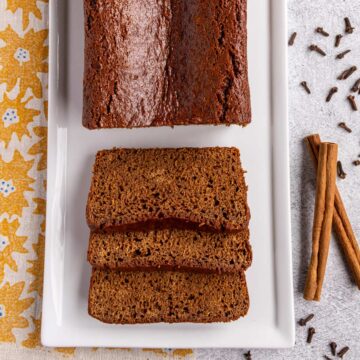
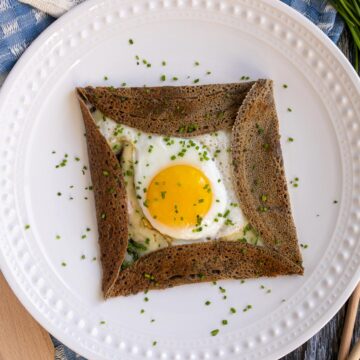
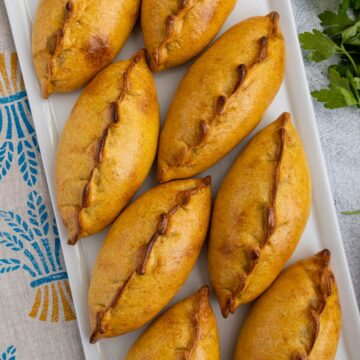
Don says
If you do the fridge first method, when do you knead in the pearl sugar?
Thanks
Victoria says
Hi Don,
Step 7 in the recipe card states to add the pearl sugar right before you plan to cook the waffles with either proofing method. I hope this helps!
Jane says
Tried them! Came out absolutely great. Just remember that this kind of waffle comes out really sweet. Not sure how much less sugar you could add to have them less sweeter and still get that carmelisation on the outside. For us they were great just they were, didn't need any kind of toppings.
Benne says
To clean the iron afterwards, pour a mixture of cornstarch and water when the iron is hot. This will pick up the caramel/sugar leftover. Once completely white, remove like a waffle. Do both sides the same with an open iron.
Victoria says
Love this tip! Thanks for sharing. I'll have to try that next time 🙂
Abier says
Best recipe thnx they turned out amazing
Wiktoria says
Hi, I made the recipe and it’s really quite good, thank you for sharing! I’ll make it again, but with less sugar in the last step - I used the substitute (crushed sugar cubes) and they came out much sweeter than ones I had in Belgium (though my guests didn’t complain;)). So if you use the substitute sugar, I’d suggest to dial down the amount. Also great tips for cleaning the waffle maker.
Khyati says
Hi Victoria! I'm looking forward to making these delicious treats this weekend. I was wondering if any leftover dough can be frozen for any length of time? If not, could I simply halve the recipe to avoid excess?
Victoria says
Hi Khyati!
I’ve never tried to freeze this raw dough so I can’t say for sure, but I do know freezing can kill yeast. Halving the recipe should be no problem. You could also make the full recipe, cook the waffles, and then freeze some of the cooked waffles. They should be just fine to defrost and then reheat gently in a toaster oven to freshen them up. Just like you would with frozen waffles! Let me know how it goes
Sneha says
The recipe sounds delicious . I have one question which is that can we totally skip using pearl sugar in the waffles? Thanks in advance.
Victoria says
Hi Sneha. These waffles are fantastic! You could certainly skip the pearl sugar, however that is part of what makes these authentic, and provides the sugary, caramelized texture too. A substitute (though not identical) is roughly crushed sugar cubes. In lieu of that potential substitution, try without the pearl sugar and see what you think! The recipe should still work otherwise. Enjoy!